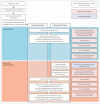Fertility preservation in women with cancer
- PMID: 25283571
- PMCID: PMC4270060
- DOI: 10.1016/S0140-6736(14)60834-5
Fertility preservation in women with cancer
Erratum in
- Lancet. 2015 Mar 7;385(9971):856
Abstract
Enhanced long-term survival rates of young women with cancer and advances in reproductive medicine and cryobiology have culminated in an increased interest in fertility preservation methods in girls and young women with cancer. Present data suggest that young patients with cancer should be referred for fertility preservation counselling quickly to help with their coping process. Although the clinical application of novel developments, including oocyte vitrification and oocyte maturation in vitro, has resulted in reasonable success rates in assisted reproduction programmes, experience with these techniques in the setting of fertility preservation is in its infancy. It is hoped that these and other approaches, some of which are still regarded as experimental (eg, ovarian tissue cryopreservation, pharmacological protection against gonadotoxic agents, in-vitro follicle growth, and follicle transplantation) will be optimised and become established within the next decade. Unravelling the complex mechanisms of activation and suppression of follicle growth will not only expand the care of thousands of women diagnosed with cancer, but also inform the care of millions of women confronted with reduced reproductive fitness because of ageing.
Copyright © 2014 Elsevier Ltd. All rights reserved.
Figures
Comment in
-
Contraception is as important as fertility preservation in young women with cancer.Lancet. 2015 Feb 7;385(9967):508. doi: 10.1016/S0140-6736(15)60201-X. Lancet. 2015. PMID: 25705843 No abstract available.
References
-
- Howlader N, Noone AM, Krapcho M, et al. SEER cancer statistics review, 1975–2010. National Cancer Institute; http://seer.cancer.gov/csr/1975_2010/ (accessed Sept 18, 2014)
-
- Forman EJ, Anders CK, Behera MA. A nationwide survey of oncologists regarding treatment-related infertility and fertility preservation in female cancer patients. Fertil Steril. 2010;94:1652–56. - PubMed
-
- Practice Committee of American Society for Reproductive Medicine Fertility preservation in patients undergoing gonadotoxic therapy or gonadectomy: a committee opinion. Fertil Steril. 2013;100:1214–23. - PubMed
Publication types
MeSH terms
Substances
Grants and funding
LinkOut - more resources
Full Text Sources
Other Literature Sources
Medical


